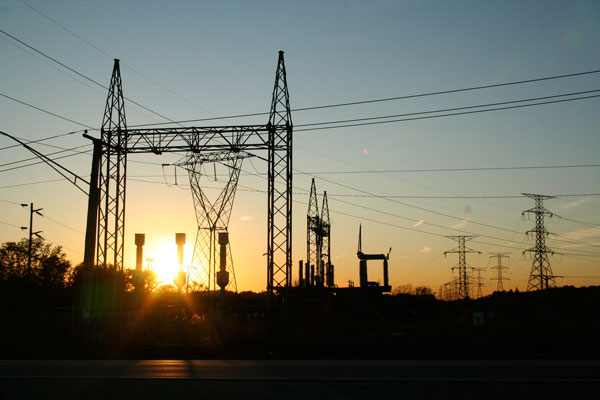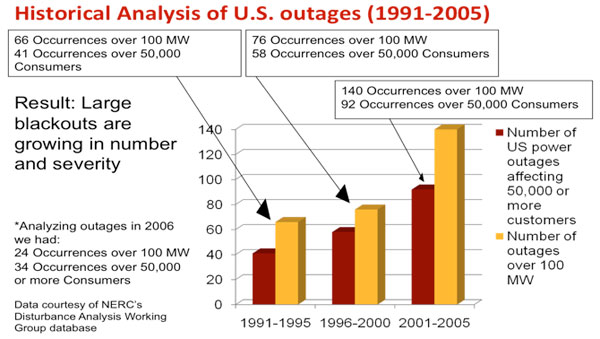
Steve Rhodes writes: "Maybe ComEd should just start announcing who has power."
ComEd has been getting blasted this year for power outages in the Chicagoland area, more than usual, at least in my anecdotal experience. Meanwhile, Irene has shut off electricity in vast swaths of the Northeast. Having grown up in a rural, mountainous area in the Southeast, where ice storms are less frequent but tend to be worse, I lived through days-long power outages—once watching the Winter Olympics by hooking up a portable ’70s TV to a row of D batteries lined up on the floor, probably not the safest thing to do in retrospect—and kind of assumed that power outages were an intractable part of life, and, you know, cityfolk.
Nothing more than usual. We cooked on the woodstove, having to throw out all the food in your fridge builds character, etc.
But it turns out y’all aren’t crazy:

That’s from a piece by Dr. Massoud Amin of the University of Minnesota, in which he advocates for the development of a national smart grid, an ongoing issue this year within Illinois:
In summary, a stronger and smart grid would pay for itself by increasing efficiency by 5% (translating into $20.4 billion in savings annually) and reducing costs of outages by about $49 billion per year. It’d also reduce emissions by 12-18% per year, increase overall energy security and spur economic growth.
It’s broadly accepted that the nation’s electrical infrastructure is aging. But there’s another theory for the increase in U.S. power outages: deregulation. The nation’s electrical grid was predicated on the existence of highly regulated large regional monopolies. The deregulation of power utilities changed the way power is distributed throughout the country, and the increased complexity of the market went hand in hand with an increase in the complexity of distribution, as Eric Lerner describes:
In the view of Casazza and many other experts, the key error in the new rules was to view electricity as a commodity rather than as an essential service. Commodities can be shipped from point A through line B to point C, but power shifts affect the entire singlemachine system. As a result, increased long-distance trading of electric power would create dangerous levels of congestion on transmission lines where controllers did not expect them and could not deal with them.
The problems would be compounded, engineers warned, as independent power producers added new generating units at essentially random locations determined by low labor costs, lax local regulations, or tax incentives. If generators were added far from the main consuming areas, the total quantity of power flows would rapidly increase, overloading transmission lines. “ The system was never designed to handle long-distance wheeling,” notes Loren Toole, a transmission-system analyst at Los Alamos National Laboratory.
As Jennifer Ouellette writes, the system is "simultaneously less coordinated and more difficult to control." Among deregulation’s more notorious problems, it was grafted on to one end of a system that’s difficult to truly deregulate, and it’s arguably causing problems where the two types of market literally meet.
And, of course, per-capita electricity consumption continues to climb and transmission investment has only begun to catch up:
Electricity demand has increased by about 25% since 1990 while construction of transmission facilities decreased by about 30 percent. While annual investment in new transmission facilities has generally declined or been stagnant during the last 30 years, there has been an increase in investment during the past 5 years.
It’s not an either-or thing. These are separate but interconnected issues—localized power outages in the wake of storms are not necessarily connected to long-distance transmission issues, but smart-grid technology is connected to both (ComEd estimates that a smart grid would have kept 175,000 customers online out of 900,000 who lost power after the July 11 storm). But even in a deregulated state, transmission is still the domain of ComEd—so it’s up to us as voters, not consumers, as to how much we’re willing to pay for one, and whether or not we buy ComEd’s figures.
Photograph: juggernautco (CC by 2.0)



